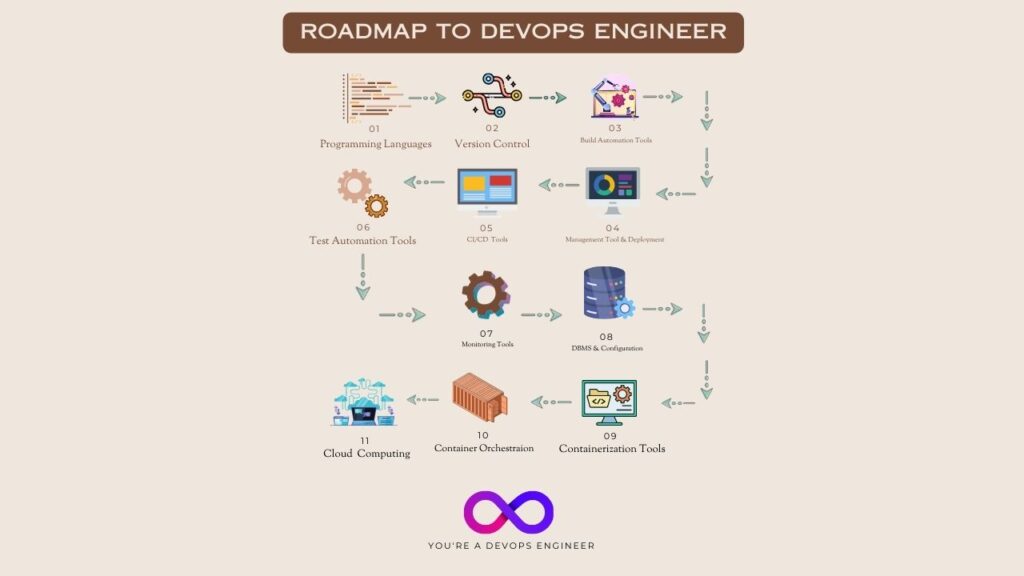Welcome to the DevOps engineer learning path. We’ll lead you through all the necessary steps to understanding DevOps in this extensive guide.
Step 1. Learn a programming language or scripting language.
You need to select and be skilled in at least one programming or scripting language to work as a DevOps engineer. Popular possibilities include Python, Ruby, and shell scripting.
Choose a language that is compatible with the demands of your project.
– Understand the syntax, data structures, and fundamental ideas.
– Regularly practice coding to develop your skills.
Step 2: Adopt Version Control for DevOps
Git and other version control tools are essential for keeping track of code changes and collaborating with other team members.
Learn the workflows and commands used by Git.
– Establish repository locations for your projects.
– Work together utilizing merging and branching.
Step 3: Make Use of Build Automation Tools
In DevOps, automation is crucial. Tools for build automation, like Jenkins or Travis CI, make software development more efficient.
Let’s get started : How to Do It Create a build pipeline for each of your projects.
– Automate processes like testing and compilation.
– Track and resolve issues with your builds.
Step 4. Deploying and managing the master configuration
For reliable and effective software delivery, configuration management technologies (such as Ansible and Puppet) and deployment procedures are crucial.
Learn the fundamentals of configuration management.
– Develop infrastructure as code and manage it.
For scalability and dependability, automate deployments.
Step 5: Immerse yourself in CI/CD Tools
Tools for continuous integration (CI) and continuous deployment (CD) make it possible to release software automatically and often.
Implement CI/CD pipelines using applications like Jenkins or GitLab CI/CD.
– Automate deployment, monitoring, and testing.
– Ensure pipeline-wide code security and quality.
Step 6: Use tools for test automation
Selenium and JUnit, among other test automation technologies, guarantee that your code runs consistently and correctly.
Write scripts for automated test execution.
– Include testing in the CI/CD workflow.
– Keep an eye on test findings and respond quickly to problems.
Step 7 : Implement Logging and Monitoring Tools.
For quickly locating and fixing problems, effective logging and monitoring (such as ELK Stack and Prometheus) are required.
How to Do It: Configure your infrastructure’s monitoring and alerting.
Consolidate logs for simple analysis.- Design dashboards to show the state of the system.
Step 8: Use Excel to Manage, Configure, and Manage Databases
In DevOps, database skills are essential. Take the overview of database management systems, such as MySQL and PostgreSQL.
Become an expert in SQL queries and database design.
– Automate database maintenance and backup procedures.
– Enhance database operation.
Step 9: Look at Containerization Tools
Consistent and effective application packaging and deployment are made possible by containers (like Docker).
How to Implement: Educate yourself on containerization principles.
– Make containers for your apps with Docker.
– Employ container orchestration for administration and scalability.
Step 10 : Master Container Orchestration
At scale, containerized applications are managed by container orchestration platforms like Kubernetes.
Before proceeding learn the fundamentals of Kubernetes
– Use Kubernetes to deploy and manage apps.
– Assure scalability and high availability.
Step 11 : Take on cloud computing
The infrastructure and services required for contemporary DevOps processes are provided by cloud services (like AWS and Azure).
Become familiar with cloud service providers and their offerings.
– Manage and deploy cloud-based apps.
– Reduce expenses and maintain security.
You are a DevOps Engineer.
Congratulations! You can become a skilled DevOps engineer who is prepared to optimize development procedures and foster innovation within your company by following these steps and continually learning from and adjusting to new situations.
Follow TechInNutshell for More 🙂







